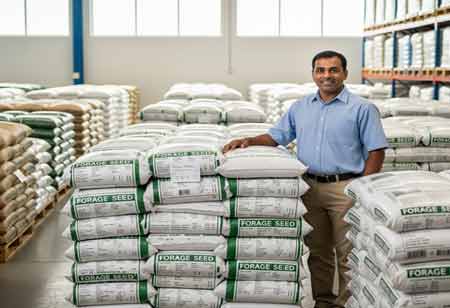Thank you for Subscribing to Agri Business Review Weekly Brief
Canada's Forage Seed Industry and Its Agricultural Legacy
Canada's forage seed industry is crucial for livestock nutrition and the agri-food economy, focusing on sustainable practices and innovation to meet rising global demand.

By
Agri Business Review | Thursday, July 24, 2025
Stay ahead of the industry with exclusive feature stories on the top companies, expert insights and the latest news delivered straight to your inbox. Subscribe today.
Canada's diverse agricultural landscape depends on a strong forage seed industry, which underpins the livestock sector and plays a vital role in the broader agri-food economy. Forages, encompassing a wide array of grasses and legumes, are indispensable for feeding cattle, dairy, and other ruminant animals, providing essential nutrition through pasture, hay, and silage. The demand for high-quality forage seeds is consistently driven by the needs of these animal industries, which form a substantial part of Canadian agriculture.
Cultivating Quality: From Research to Production
The forage seed supply chain in Canada is a sophisticated network that begins with the development of new varieties and culminates in their distribution to farms across the country and for export. Research and development play a crucial role, focusing on improving yield, disease resistance, nutritional value, and adaptability to Canada's varied climatic conditions. This continuous innovation ensures a steady pipeline of enhanced seed varieties that meet the evolving demands of agriculture. The breeding of new forage species and cultivars is a long-term commitment, often involving collaborations between researchers from the public and private sectors.
Once new varieties are developed and registered, the process moves to seed multiplication. This involves specialised seed growers who cultivate these crops under stringent quality control measures. The aim is to produce pedigreed seed, which adheres to specific standards for genetic purity and quality. This segment of the industry is highly regulated, with rigorous inspection and certification processes in place to maintain the integrity of the seed supply. These regulations encompass the entire process, from field inspection to post-harvest cleaning, conditioning, testing, and grading, ensuring that only high-quality seed reaches the market.
Canadian forage seed producers cultivate a diverse range of species tailored to different regional climates and the specific requirements of various livestock. Key grasses include various brome species, timothy, orchardgrass, fescues, and ryegrasses. Legumes are also vital, with alfalfa and various clovers being widely grown for their high protein content and nitrogen-fixing properties, which benefit soil health. The selection of specific forage species often depends on factors such as intended use (grazing, hay, or silage), soil type, moisture availability, and the specific nutritional needs of the livestock. For instance, alfalfa is highly valued for its deep root system and ability to thrive in various conditions, while timothy is a traditional and essential crop, particularly in certain regions.
Economic Contributions and Geographic Focus
Geographically, forage seed production in Canada is concentrated in specific areas, with the western provinces, particularly parts of British Columbia, Alberta, Saskatchewan, and Manitoba, being significant contributors. The Peace River region, spanning parts of British Columbia and Alberta, is particularly renowned for its forage seed output. These regions possess suitable climates and agricultural infrastructure that support large-scale seed production. While a substantial portion of forage is grown and consumed on the same farm, there is also a vibrant commercial market for forage seeds, with a significant amount of Canadian production destined for export, particularly to the United States and Europe.
The economic significance of the forage seed industry extends beyond the farm gate. It supports a range of related businesses, including seed processing facilities, transportation and logistics providers, as well as marketing and distribution channels. The value generated by the industry contributes to rural economies through employment and business activity. The availability of high-quality forage seeds underpins the profitability and sustainability of the broader livestock sector, which is a significant economic driver for Canada. The industry is also increasingly recognising the value of residual forage material, such as straw, which can be harvested and marketed, further enhancing economic returns.
From a technological standpoint, the forage seed sector in Canada continuously integrates advancements to enhance efficiency and productivity. This includes improved cultivation practices, precision agriculture techniques for optimal seeding and nutrient management, as well as sophisticated seed processing technologies that ensure high purity and germination rates. Research into drought-resistant varieties and those with enhanced nutrient profiles is ongoing, responding to evolving environmental conditions and the demand for more efficient feed sources. The industry also benefits from ongoing agronomic research that informs best practices for stand establishment, maintenance, and renovation, optimizing long-term seed productivity.
Sustainable Growth and Future Outlook
Sustainability is an increasingly central theme within the Canadian forage seed industry. Practices that promote soil health, biodiversity, and responsible resource management are gaining prominence. The use of perennial forage crops, for instance, contributes to reduced soil erosion, improved water infiltration, and carbon sequestration. There is a growing interest in integrating forages into diversified cropping systems and leveraging their benefits for nutrient cycling and overall ecosystem health. The development of seed varieties that require fewer inputs or are more resilient to changing environmental conditions aligns with broader agricultural sustainability goals.
The outlook for the Canadian forage seed industry remains positive. Global demand for animal protein continues to rise, which in turn fuels the need for high-quality forage. Ongoing research into new varieties, coupled with the adoption of advanced agricultural technologies, positions the industry for continued growth. The emphasis on sustainable production practices further enhances the marketability of Canadian forage seeds, both domestically and internationally. As the agricultural landscape evolves, the Canadian forage seed sector is poised to adapt and innovate, continuing its vital role in supporting livestock production and contributing to the nation's economic prosperity.





